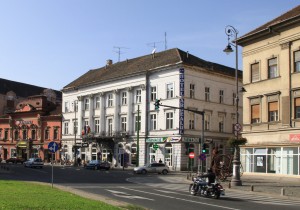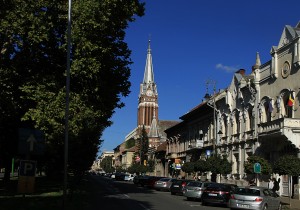The Church of the Minorites Order, located in the centre of Arad, was built in 1902-1903 on the former site of a Baroque church, according to a project developed by architect Emil Tabacovits from Arad. The entrance is highlitghted by a copy of Michelangelo’s Pietà statue, which stands above it.
History
The Roman Catholic Cathedral is part of the minorite compound, built in the center of Arad. The building’s history begins in 1902, when the construction of the new building started after the demolition of the old baroque church that had occupied the site. The works ended in 1904, while numerous details of the church’s interior could not be finished earlier than in 1911: the altar ornamentation, mural painting and stained glass windows.
The author of the project for this beautiful building is local architect Emil Tabacovits. In 1926, according to an inscription, the House of Culture for catholic minorities was built in the church’s yard.
Architecture
The church was rendered in eclectic style, with elements of Baroque, Classicism and Renaissance. The main entrance is framed by four massive columns with corinthian capitals. Above the entrance, there is a copy of Michelangelo’s Pieta statue. The building measures 43 m in length and 17 m in width.
The cross on the dome is located at a height of 56 m. Above the white marble altar, a painting of György Vastagh is placed, representing the Cathedral’s patron, St. Anthony of Padua. Above the side altars, at the right side of the nave, there are Baroque paintings relocated from the former church - the works of painter Ferdinand Schissler. The stained glass windows are true masterpieces.
Interesting facts
The huge tower of the building sits at about 56 m high. Whithin it, the big bells, molded at the local Hönig workshop, are installed. At the entrance, ten stained-glass windows mark their presence due to their impressive craft, depicting themes typical of the Roman Catholic rite. On the right, the wall of the narthex bears an inscription which stands as a reminder of the visit of Emperor Joseph II.
The Church is dedicated to Saint Anthony of Padua, thus the painting of the altar, work of John Vastagh, is inspired by his spiritual life. Above the replica of Michelangelo’s Pieta, there is a reproduction of a verse from evangelist Luke: “My house is the House of Prayer”.
The organ in the Cathedral, dating from 1905, is the largest church organ in Arad and has a special resonance, due to its 40 sound records and 1200 noise tubes.
Similar tourist attractions
„Ioan Slavici” Classical Theatre is located at the main entrance of Revolution Boulevard. Besides the theatrical seasons of the local theatre, many cultural and artistic events take place here.
Hotel "Ardealul”, under its historical name of „White CrossGrand Hotel”, was founded in the year of 1841. It has a capacity of 146 rooms and is defined by a long standing tradition.
The Romanian Evangelical Lutheran Church came into being at the end of the Great War (1914-1918), its founders being the evangelical lutheran community from the regions of Transylvania and Banat.





